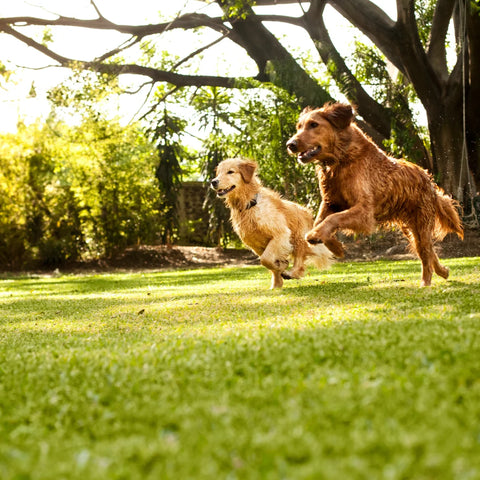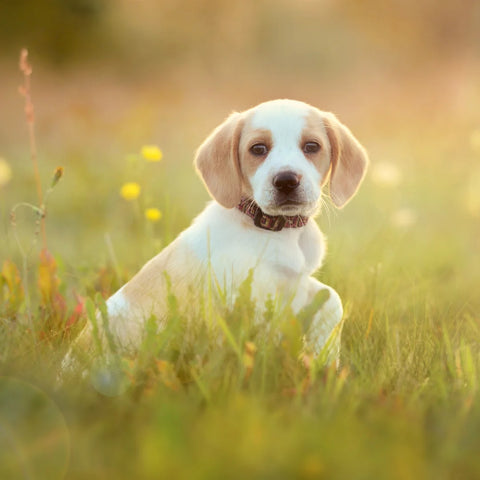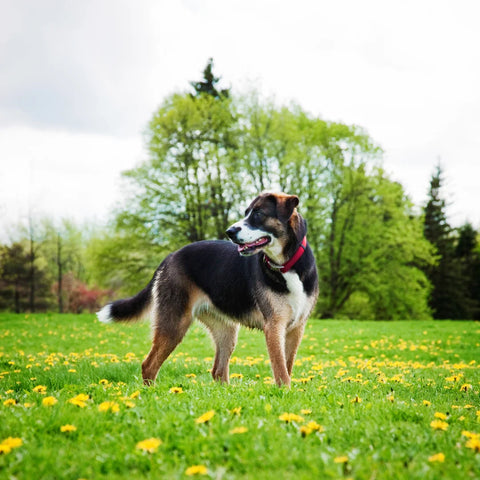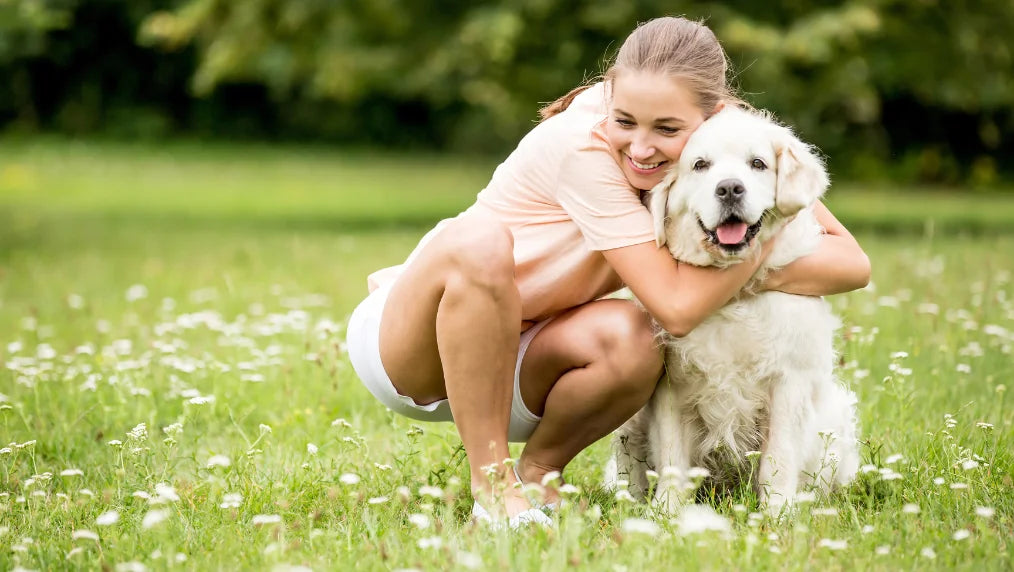As the snow begins to melt and the flowers start to bloom, it's time to start thinking about preparing your furry friend for spring. Keeping your dog well (and your pet safe too) is important all year round, but spring is a good time to review your pet’s everyday health. And you can never have too many animal safety tips for spring.
Dogs will start to spend more time outdoors in the warm weather, but it is also the season when parasites increase in number. Spring can be a delightful time for dogs, and with it comes its own set of challenges. Here are some spring pet safety tips to ensure your dog's well-being during the springtime and warmer weather months:
1. Flea and Tick Health
It is important to keep in mind that some diseases are more prevalent during the spring season. Warmer weather means more ticks. For example, Lyme disease is more common in areas where ticks are found in mass quantities. Ticks: the highly toxic parasites that spread disease by passing along bacteria, viruses, and parasites (organisms that feed off their hosts). Talk to your vet about any concerns you have regarding your dog's health and the risks associated with certain diseases.
Spring walks in long, grassy areas or woodland can increase the risk of ticks. Yes, we all want to enjoy the fresh air, but you also need to be aware of who may be creeping into your surroundings. These tiny blood-sucking parasites attach themselves to your cat or dog’s skin and must be removed straight away. Removing a tick safely is harder than it sounds. If you accidentally leave part of the head behind, you could cause an infection, so ask your vet to show you how to use a tick remover properly.”
As temperatures rise and insects start breeding at high rates, it’s time to ensure your animal is protected from flea and tick dangers. Start by removing all stagnant water sources – AKA bug breeding grounds – from your property. Next, look for natural insect repellents rather than chemical spot-on treatments, which are harmful to his health. Finally, boosts his immune system to offer an extra layer of protection from bug-borne illnesses such as Lyme disease, malaria, and heartworm. By taking these steps, you can ensure your dog is healthy and ready to enjoy the spring season.
2. Initiate Heartworm Prevention
If your pet isn’t already on year-round heartworm prevention, now’s the time to make sure your dog or cat is protected. The parasite is transmitted by mosquitoes, and infection is potentially fatal. Mosquitos can sneak indoors, so even indoor-only cats are at risk. (In one study, approximately one-third of the indoor-only cats tested were positive for heartworm infection.) Treatment can be risky and expensive for dogs, and there’s no effective treatment for cats. So prevention is the best approach.
3. Build Up Your Dog’s Physical Strength

Each spring it inevitably happens: the first warm weekend appears and people think they need to make up for four months of inactivity. They take their out-of-shape, overweight selves with their out-of-shape, overweight dogs, and decide to walk five miles, hike up their favorite mountain trail, or play an intense game of catch or Frisbee. Whatever it is, it’s too much and somebody gets hurt. This is the time of year when human ER clinics see injured knees, backs, and shoulders and veterinarians see torn cruciate ligaments, strains and sprains, and a variety of aches and pains.
Take it easy. Gradually build up your strength and stamina and understand your dog needs time to adapt as well. This is especially true in older pets. What is only four to six months to you is more like two to three years to them. And if you do overdo it, be sure and have your pet checked out immediately. The sooner you have even a minor injury checked out and treated, the sooner your pet can return to enjoying the season.
4. Spring Allergies

Just like humans, dogs can suffer from allergies too. Keep an eye out for signs such as excessive scratching, licking, or red eyes. If you notice any symptoms or skin irritation, consult your vet for advice. Pollen from trees, grasses, and weeds can cause dogs to experience symptoms such as itching, sneezing, and watery eyes. Pet owners need to recognize these symptoms and seek veterinary care if necessary.
Symptoms of seasonal allergies in dogs can be similar to those in humans. Contact with flowers, plants and grasses can cause an allergic reaction in certain pets. Dogs may scratch or lick their paws, have red or irritated skin, or experience gastrointestinal issues such as vomiting or diarrhoea. Especially when toxic. Pet owners need to monitor their dogs for any signs of discomfort and seek veterinary care if necessary. By understanding seasonal changes and taking necessary precautions, dog owners can ensure that their furry friends stay safe and healthy during the spring season. Keep your pets safe by avoiding these potential springtime hazards.
5. Clean Up The Yard

Pick up last autumn’s sticks and acorns that your pet could chew or swallow, and clear away leaf litter where ticks like to hide. Check your gardening supplies to make sure any lawn fertilizers, mulch or pest control products that may be toxic are out of your pet’s reach.
6. Spring Grooming
Spring is often associated with shedding. In the spring, your dog's coat will become lighter, in preparation for the warm weather. Similarly, in the fall, in preparation for winter, you will see a change in your dog's hair and a higher incidence of shedding. Many dog breeds have a natural shedding cycle that is tied to the specific seasons. In the spring, dogs will often shed their thick coat in the winter to make way for a lighter summer coat. In the fall, they will shed their summer coat to grow thicker winter coats.
This shedding is often more noticeable in double-coated breeds with thick undercoats, such as a German Shepherd, Husky, and Alaskan Malamute. The coat type has a lot to do with how much breeds shed. While shedding is a natural process that cannot be eliminated, there are several things that dog owners can do to manage shedding and keep their homes clean:
7. Groom Your Dog Regularly
Regular grooming with a professional groomer is one of the best ways to manage shedding in dogs. Especially during shedding season. Grooming helps to remove loose hair, dirt, and debris from your dog’s coat, reducing the amount of hair they shed.
For pet parents who are grooming their dogs at home, use a brush or comb designed for your dog’s coat type to remove loose pet hair, and prevent mats and tangles. The proper shampoo to remove dead hair in our furry friends will also help keep dog hair loss at bay.
We Recommend: THE SHEDDER SHAMPOO and THE ONLY BRUSH by PRIDE+GROOM
- Brush your dog regularly to remove excess fur and prevent matting. This is especially important for dogs with thick coats.
- Whether your dog has hair, or fur, or is just a bit sensitive, the coat-specific PRIDE+GROOM shampoo formulas were created to care for every coat and the skin beneath. Dazzling results give even the best human brands a run for their money.
8. Spring Cleaning Safety
As you rush to clean out your garage and prep your yard during what we call "spring cleaning", remember these activities may pose a risk to your pet. Many cleaning products, fertilizers, pesticides, weed-killers, and even mulch can all be dangerous to dogs and cats. The same goes for the dangers of home improvement projects. This is true for all pets but especially cats since they can jump on high surfaces and reach things that dogs often cannot.
Remember, our pets can’t read warning labels or bottles of cleaning products. If a dog or cat ingests something poisonous or toxic, it can lead to many major issues and even death. Look out for your little ones as you go about greening your homes and keep dangers out of paw's reach.
9. Hydration
Warmer temperatures mean increased water needs. Make sure your dog always has access to fresh water, especially during outdoor activities. Water serves many vital purposes for the dog's body, such as keeping them hydrated, removing waste, assisting in proper digestion, and promoting good urinary tract health.
10. Vet Check-up
Schedule a spring check-up with your veterinarian. This is a good time to ensure vaccinations are up-to-date and discuss any concerns or preventive measures. Staying on top of your pet’s vaccinations is especially important during springtime. Dogs are spending more time in the park with each other and are likely to come across some new puppy, or raccoon or squirrel, friends. Keeping their rabies, parvo, and distemper vaccinations up to date will help protect your pup from potentially deadly diseases. This is especially important if you own a small puppy, so be sure not to miss an appointment at the vet for a shot.
11. Identification
With more outdoor activities and more walks, ensure your dog's ID tags are updated with current information. This is important for cats too. Microchipping is also a good way to increase the chances of being reunited with your pet if they get lost.
12. Springtime Foods
Be mindful of seasonal changes in your dog's diet. Fresh fruits and vegetables like apples, carrots, and berries can be healthy treats. However, for pets avoid giving them foods that may be harmful, such as certain spring plants.
13. Visiting Dog Parks Safely

Dog parks are an excellent way to socialize your dogs and prepare them for spring. However, it is essential to visit dog parks safely. Before visiting a dog park, ensure that your dog has a leash, collar, and ID tag. It is also essential to choose the right leash for your dog. When visiting a dog park, it is important to monitor your dog's behaviour. If your dog is playing too rough or showing signs of aggression, it is time to leave the park.
Additionally, it is essential to clean up after your dog and ensure that they are up to date on their vaccinations. Enrolling your dog in a training class and visiting dog parks safely are essential for preparing your dog for spring and outdoor playtime. By following these tips, you can ensure that your dog is happy, healthy, and well-behaved.
Conclusion
In conclusion, preparing your dog for the spring season is a multifaceted process that involves ensuring their health and safety, adjusting their care routine to the changing weather, and providing them with the right environment and activities to thrive. From updating vaccinations and preventive medications to gradually increasing exercise routines, every step taken is crucial for their well-being. Grooming, diet adjustments, and socialization also play significant roles in helping your dog transition smoothly into the warmer months. Moreover, taking preventive measures against pests and parasites, maintaining dental hygiene, and keeping their living space clean are essential practices to keep your furry friend happy and healthy. By attentively addressing these aspects, you can ensure that your dog enjoys the beauty and vibrancy of spring to the fullest, making the most of this delightful season together.


